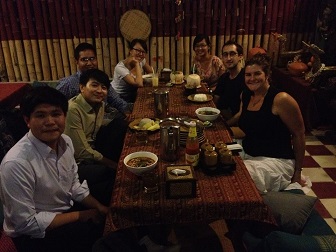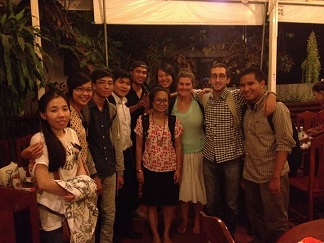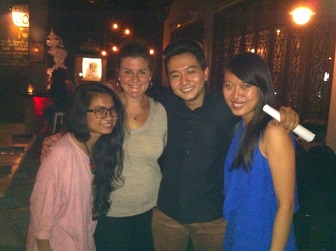Work, work, work...and some fun
It is hard to believe that we are halfway through our summer in Phnom Penh and our internship at ODC! Since starting work five weeks ago, our days have almost entirely been spent researching rubber in Cambodia, or in my case, the greater Mekong region, and working with the Khmer staff to update spreadsheets of economic land concessions in Cambodia. This week offered a little variety to our daily routine, as we had the opportunity to sit in on a couple of meetings at the beginning of the week and then present our research findings to our colleagues at the end of the week. On Tuesday, we participated in the weekly editorial team meeting, where the participants provided updates on the projects they had been working on and discussed upcoming projects. It was an interesting and enlightening look behind the scenes of the organization, witnessing the group dynamics and gaining a greater understanding of some of the strengths and challenges of the organization. In the afternoon, we sat in on a meeting between the executive director of ODC, a gentleman who is doing research on the impact of industrialization in Southeast Asia, and an individual from the German think tank who is backing his research. We discussed industrialization, hydroelectric power, and Chinese involvement in the region, among other topics, and though it was unclear what each side was seeking from the other or how either side would move forward, it was an interesting discussion to be a part of.
On Friday, Ross and I presented our rubber research to ODC. Ross’s paper on the rubber industry in Cambodia got rave reviews from the executives, as they were quick to point out that it was one of the best research papers they’d ever received. Well-deserved praise. He started off the lunch session with a discussion of the history of rubber in Cambodia, from its beginnings in the early 1900s under French colonialism through the present, focusing on the transition from state owned plantations to privately owned plantations, the evolution of economic land concessions in the 1990s, and the fluctuation in the rubber market as the industry responded to political and economic events. It was an educational presentation and inspired much discussion among attendees about other areas for future exploration. If he decides to abandon his career in law, he most certainly has enough material for a dissertation….
With time quickly running out, I spoke for just a few moments about the regional trends that I’ve noticed while doing my research on the rubber industry in the greater Mekong region (Cambodia, Laos, Myanmar, Thailand, and Vietnam). Rubber production in Southeast Asia has increased dramatically over the last couple of decades. Asia supplies 97% of the world’s natural rubber, with Thailand alone accounting for almost 1/3 of the world’s supply. In 2013, Thailand, Vietnam and Cambodia were among the top 10 rubber producing countries, with Cambodia experiencing the most dramatic increase from its 2012 production figures, at a staggering 32.4% increase. This increase in rubber production has been marked by a number of trends. First, rubber production has and continues to expand into non-traditional growth areas. Traditional growth areas of Southeastern Vietnam, Southern Thailand, and Southern Myanmar have been supplemented by expansion into the non-traditional areas of Northwestern Vietnam, Northeastern Thailand, Northern Myanmar, Laos, and Northern Cambodia. Over the last several decades, more than one million hectares of land have been converted for rubber production in Cambodia, Laos, Myanmar, Thailand, Vietnam, and China. The second major trend that I came across is that the rate of growth in each of these countries is far outpacing expectations. Not only has the rubber plantation acreage expanded dramatically, but so have the rates of production. Thailand, Vietnam and Laos have all surpassed 2007 projections for production in 2020, and Cambodia is on pace to meet, if not exceed those projections. A third regional trend is the expansion of large scale rubber plantations in the region, and a fourth is the increase of foreign investment in rubber production (especially China, Vietnam and Thailand (the latter two in the other countries in the region)). I will discuss these trends in more detail at our follow up brown bag lunch next Friday, as well as go into country specific discussions of the history of rubber production, current production figures, the legal and policy framework within which the industry operates, and some concerns related to the expansion of the rubber industry in each of the five countries.
But this week has not been all about work. For me, the highlight of the week was spending quite a bit of time with our Khmer colleagues outside of the office. We went to two group dinners, both of which featured fabulous food and even better company. It was really nice having the time to talk with people in a more informal setting and hear about their families, their educations, their interests, and what they would like to do going forward. Our colleagues are an incredibly diverse and smart and funny group of individuals, and I can’t wait to spend more time with them in the next few weeks. During one of these outings, they also bestowed each of us with Khmer nicknames. Mine is Srey Kouch, which means “dimples.” (I am not even going to attempt to write the pronunciation, because every time I say it wrong, which is dangerous because the word is very similar to a less flattering term…) Needless to say, we kept them thoroughly entertained with our horrible pronunciation as we attempted to learn our new names and expand our Khmer vocabulary. We had a blast, and cannot wait to do it again!! We ended the week by attending the concert of one of our colleagues (a rising star in the Cambodian music scene), and then going out for a group karaoke session afterwards. It was an embarrassing display, following in his footsteps, but we had a great time!


